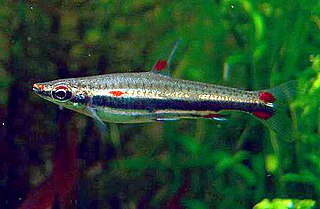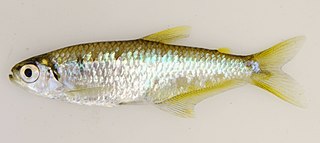
Hyphessobrycon is a genus of freshwater fish in the family Characidae. These species are among the fishes known as tetras. The genus is distributed in the Neotropical realm from southern Mexico to Río de la Plata in Argentina. Many of these species are native to South America; about six species are from Central America and a single species, H. compressus is from southern Mexico.

Nannostomus is a genus of fish belonging to the characin family Lebiasinidae. All of the species in this genus are known as pencil fish, a popular name that was initially only applied to two species in the 1920s, Nannostomus unifasciatus and Nannostomus eques, by the late 1950s however, the term would be applied to all members of the genus. Several species have become popular aquarium fish due to their attractive coloration, unique shape, and interesting demeanor.

Jenynsia is a genus of freshwater fishes in the family Anablepidae. Like Anableps species, they are onesided livebearers: some sources indicate that they only mate on one side, right-"handed" males with left-"handed" females and vice versa. However, other sources dispute this. These South American fish are viviparous.
Priocharax is a genus of characins, very small freshwater fish from the Amazon and Orinoco basins in tropical South America.

Glandulocaudinae are a subfamily of tropical freshwater characin fish from Central and South America. In all species of this subfamily, a gland on their caudal fin is found almost exclusively in the males, which allows the release and pumping of pheromones; also, members of this subfamily have complex courtship behaviors which lead to insemination. The ecology and life history of these fish is complex yet little studied. Glandulocaudines are important as food fish for larger fish important for commercial and subsistence reasons.
Scoloplax is the only genus in the catfish family Scoloplacidae, the spiny dwarf catfishes.
Mimagoniates is a genus of characid fish from rivers and streams in southeastern, southern and central-western Brazil, northeastern Argentina, and Paraguay. The individual species generally have relatively small ranges and two, M. lateralis and M. sylvicola, are considered threatened by Brazil's Ministry of the Environment.

Nematobrycon is a genus of characins endemic to the Atrato and San Juan River basins in western Colombia. The two described species in this genus are very popular aquarium fish.

Aphyocypris is a genus of cyprinid fishes consisting of eight species, all of which are restricted to East Asia.

Diapoma is a genus of characins from tropical South America.
Glandulocauda is a genus of small characin freshwater fish that are endemic to Brazil, where restricted to the upper Paraná basin and coastal river basins in São Paulo state. The genus it is closely related to Lophiobrycon and Mimagoniates, and they form the tribe Glandulocaudini.
Hysteronotus megalostomus is a species of characin endemic to Brazil where it is found in the upper São Francisco River basin. This species is the only member of the genus Hysteronotus.
Knodus is a genus of characins, small freshwater fish from South America.
Lepidocharax is a genus of characins endemic to the Doce, Paraguaçu and São Francisco basins in eastern Brazil. They are small fish, that reach up to 4 cm (1.6 in) in standard length.
Nematocharax is a genus of freshwater fish in the family Characidae. It contains the single species Nematocharax venustus, which is endemic to Brazil, where it is found in the Jequitinhonha River basin. The males of this species can reach a length of 5.1 centimetres (2.0 in) SL while the females only grow to 3.5 centimetres (1.4 in) SL.
Planaltina is a genus of characins endemic to Brazil.
Spintherobolus is a genus of characins that are endemic to river basins in southern and southeastern Brazil from Santa Catarina to Rio de Janeiro. All four species in the genus are considered threatened by Brazil's Ministry of the Environment. They are small fish, up to 6.1 cm (2.4 in) in standard length.
Elachocharax is a genus of small fish in the family Crenuchidae. They are native to the Amazon and Orinoco basins in South America.

Pyrrhulina is a genus of freshwater fishes found in tropical South America. Several of these species are popular aquarium fish.
Stanley Howard Weitzman was a Research Scientist Emeritus at Division of Fishes, National Museum of Natural History, Washington, D.C.







